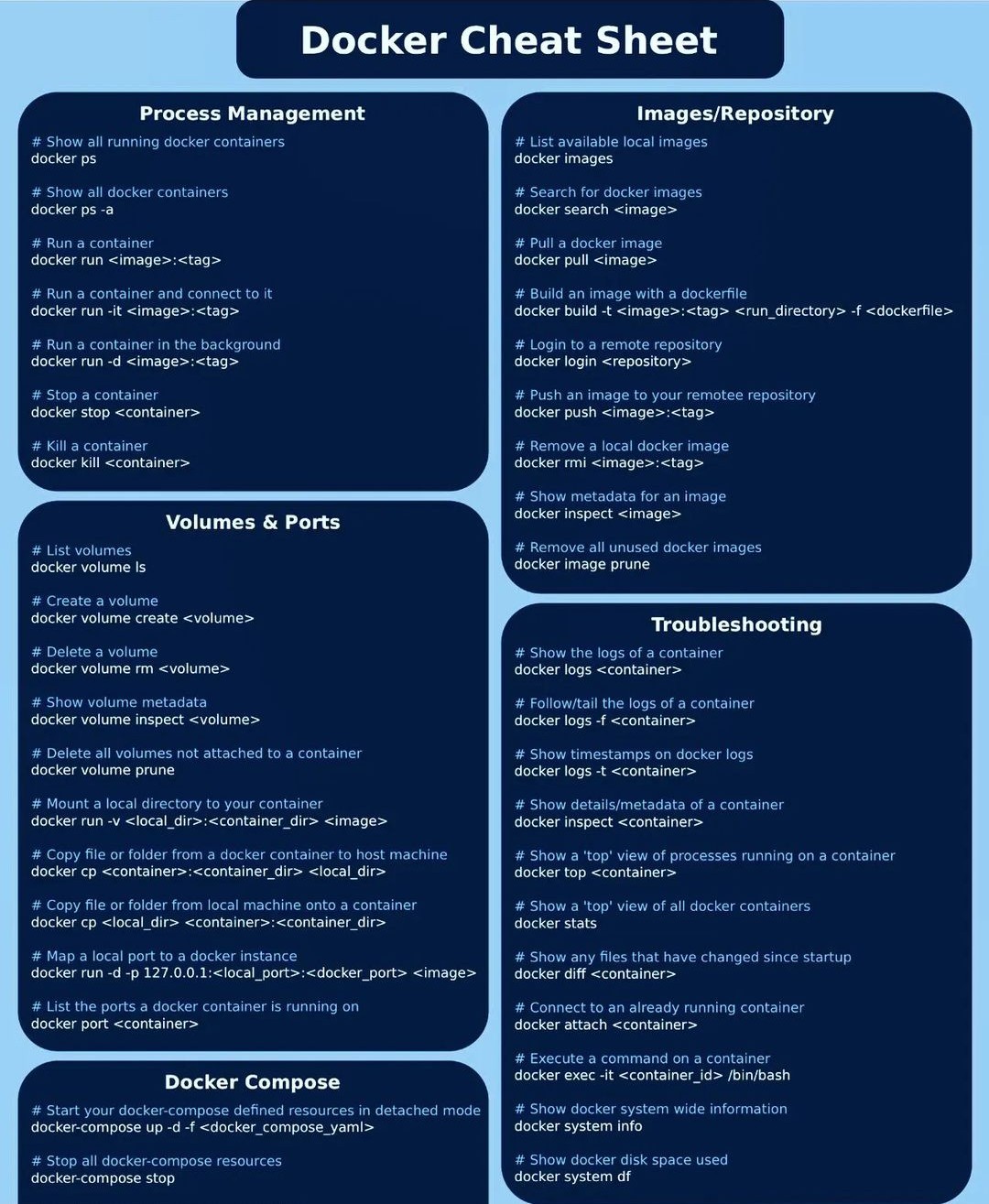Docker Commands Cheat-Sheet
 Ashwin
Ashwin🚀Introduction
As we delve into the dynamic landscape of DevOps, containerization stands out as a game-changing phenomenon, completely transforming the deployment and scalability of applications📦🚀
At the forefront of this transformative shift lies Docker – a robust platform that empowers the packaging, distribution, and execution of applications within self-contained containers🐳📦
Within this piece, we present a comprehensive compilation of Docker commands, covering tasks such as managing images and containers, orchestrating networks, and navigating complex implementation scenarios, offering you a one-stop reference for all your Docker needs📚🐳

📋General Commands
Essential commands like version information retrieval, system analysis, and help index access lay the groundwork for a successful Docker journey💼🔍
✔Display detailed information about your Docker CLI and daemon versions:
docker version
✔List data about your Docker environment, including active plugins, containers, and images:
docker system info
✔View the help index, which provides references for all supported commands:
docker help
✔View detailed help information about a specific command, including option flags:
docker <command> --help
🏗️Build Images
Constructing Docker images using Dockerfiles and tags facilitates the creation of custom and optimized environments. Options for setting build arguments and pulling updated images enhance flexibility.
✔Build the Dockerfile in your current directory into a new image:
docker build .
✔Build the Dockerfile in your current directory and tag the image as example-image:latest:
docker build -t example-image:latest .
✔Build the Dockerfile located at docker/app-dockerfile path:
docker build -f docker/app-dockerfile
✔Build an image while setting the foo build argument to bar:
docker build --build-arg foo=bar .
✔Instruct Docker to pull updated image versions referenced in FROM instructions before building:
docker build --pull .
✔Build an image quietly without emitting build output:
docker build --quiet .
🏃Run Containers
Launching containers from images is a core Docker operation. Commands for naming, connecting to networks, setting environment variables, and handling restart policies enable fine-grained control over container behavior.
✔Run a new container using the example-image:latest image:
docker run example-image:latest
✔Run a command inside the container while appending it to the image's entry point:
docker run example-image:latest demo-command
✔Run a container and automatically remove it when it exits:
docker run --rm example-image:latest
✔Detach your terminal from the running container, leaving it in the background:
docker run -d example-image:latest
✔Attach your terminal and a TTY to the container for interactive commands:
docker run -it example-image:latest
✔Name the new container as my-container:
docker run --name my-container example-image:latest
✔Set the container's hostname to my-container:
docker run --hostname my-container example-image:latest
✔Set an environment variable foo=bar inside the container:
docker run --env foo=bar example-image:latest
✔Populate environment variables from the file config.env:
docker run --env-file config.env example-image:latest
✔Bind port 8080 on the host to port 80 inside the container:
docker run -p 8080:80 example-image:latest
✔Bind mount a directory from the host to the container:
docker run -v /host-directory:/container-directory example-image:latest
✔Mount a Docker volume named data to /data inside the container:
docker run -v data:/data example-image:latest
✔Connect the container to a Docker network named my-network:
docker run --network my-network example-image:latest
✔Set the container to restart automatically unless manually stopped:
docker run --restart unless-stopped example-image:latest
✔Run the container with privileged access to the host system:
docker run --privileged example-image:latest
🛠️Manage Containers
Efficiently handle running and stopping containers, from listing and attaching to them to committing states, inspecting details, and managing lifecycles.
✔List all running containers:
docker ps
✔List all containers, including stopped ones:
docker ps -a
✔Attach your terminal to a container's foreground process:
docker attach <container>
✔Save a container's state to a new image:
docker commit <container> new-image:latest
✔Retrieve detailed information about a container in JSON format:
docker inspect <container>
✔Send a SIGKILL signal to a container's foreground process to force it to stop:
docker kill <container>
✔Rename a container:
docker rename <container> my-container
✔Pause and unpause processes within a container:
docker pause <container>
docker unpause <container>
✔Stop a running container:
docker stop <container>
✔Start a stopped container:
docker sart <container>
✔Delete a container by its ID or name:
docker rm <container>
📂Copy to and From Containers
Seamlessly transfer files between containers and the host system with ease, streamlining development and data management.
✔Copy a file from your host to a container:
docker cp example.txt my-container:/data
✔Copy a file from a container to your host:
docker cp my-container:/data/example.txt /demo/example.txt
If transferring files between two containers, copy from the first to your host, then from your host to the second container.
💻Execute Commands in Containers
Execute commands interactively or non-interactively within running containers, enabling efficient debugging and maintenance.
✔Run a process inside a container and display the output:
docker exec my-container demo-command
✔Run a command interactively within a container:
docker exec -it my-container demo-command
📜Access Container Logs
Easily access and follow container logs for monitoring and troubleshooting purposes.
✔Stream existing container logs and exit:
docker logs <container>
✔Stream existing and new logs continuously:
docker logs <container> --follow
✔Get the last 10 logs from a container:
docker logs <container> -n 10
Container logs consolidate data from standard output and error streams of the container's foreground process.
📊View Container Resource Utilization
Monitor resource consumption of containers to optimize performance and resource allocation.
✔Stream resource utilization information for a container:
docker stats <container>
This provides details about CPU, memory, I/O usage, and the number of running processes.
🏞️Manage Images
List, tag, and delete images as needed, ensuring efficient image management and storage utilization.
✔List all stored images:
docker images
✔Delete an image by its ID or tag:
docker rmi <image>
✔Add a new tag to an existing image:
docker tag <image> example-image:latest
🚀Pull and Push Images
Seamlessly manage images on remote registries, allowing for efficient distribution and sharing.
✔Push an image to a remote registry:
docker push example.com/user/image:latest
✔Pull an image from a remote registry:
docker pull example.com/user/image:latest
🌐Manage Networks
Create, connect, and disconnect containers from networks, facilitating communication and isolation between services.
✔Create a new network (default bridge driver):
docker create network my-network
✔Create a new network with an alternative driver, e.g., host:
docker create network my-network -d host
✔Connect a container to an existing network:
docker network connect <network> <container>
✔Remove a container from a network:
docker network disconnect <network> <container>
✔List available Docker networks, including built-ins like bridge and host:
docker network ls
✔Delete a network (when no containers are connected):
docker network rm <network>
📦Manage Volumes
Handle data storage effectively with volume creation, listing, and removal commands.
✔Create a new named volume:
docker volume create my-volume
✔List volumes on your host:
docker volume ls
✔Delete a volume (ensure it's not used by any container):
docker volume rm <volume>
🏢Docker Hub Account
Interact with Docker Hub to facilitate image sharing and management.
✔Login to your account:
docker login
✔Log out of your account:
docker logout
✔Search Docker Hub for images:
docker search nginx
🧹Clean Up Unused Resources
Maintain a clutter-free Docker environment by removing unused resources and optimizing space
✔Remove unused data, including dangling image layers:
docker system prune
✔Remove all unused images:
docker system prune -a
✔Remove volume data along with other unused resources:
docker system prune --volumes
✔Remove dangling images:
docker image prune
✔Remove all unused images:
docker image prune -a
✔Remove unused networks:
docker network prune
✔Remove unused volumes:
docker volume prune
✔View the Docker installation's total disk usage:
docker system df
These prune commands require confirmation before resource deletion. The -f (force) flag can be used to bypass the prompt.
📄Dockerfile
A Dockerfile is a script that contains a set of instructions for building a Docker image.
✔Create a Dockerfile:
Create a file named Dockerfile (no extension) in your project directory and define instructions.
✔Build an Image Using a Dockerfile**:**
docker build -t my-image:latest .
This builds an image using the Dockerfile in the current directory.
✔Specify a Different Dockerfile:
docker build -t my-image:latest -f path/to/Dockerfile .
This builds an image using a Dockerfile at a specified path.
✔Use Build Arguments:
docker build -t my-image:latest --build-arg key=value .
This passes build arguments to the Dockerfile.
✔Build without Caching:
docker build -t my-image:latest --no-cache .
This forces a fresh build without using the cache.
✔Set Image Metadata:
docker build -t my-image:latest --label key=value .
This sets labels on the image.
✔Set Work Directory:
WORKDIR /app
This sets the working directory in the Docker image.
✔Copy Files to Image:
COPY src/ /app/
This copies files from the local machine to the image.
✔Run Commands in Image:
RUN apt-get update && apt-get install -y package-name
This runs commands during image build.
✔Expose Ports:
EXPOSE 80
This exposes a port when the container runs.
✔Set Environment Variables:
ENV key=value
This sets environment variables in the image.
✔Set Container Execution Command:
CMD ["executable", "arg1", "arg2"]
This sets the default command to run when the container starts.
✔Set Container Entrypoint:
ENTRYPOINT ["executable", "arg1"]
This configures the entry point for the container.
✔Add Metadata to Describe the Image:
LABEL key=value
This adds metadata labels to the image.
These commands and instructions allow you to work with Docker Compose to manage multi-container applications and create customized Docker images using Dockerfiles.
🎵Docker Compose
Docker Compose is a tool for defining and running multi-container Docker applications. It uses a YAML file to configure and manage the services, networks, and volumes of your application.
✔Define and Run Multi-Container Applications:
docker-compose up
This command starts the services defined in your docker-compose.yml file.
✔Build and Run:
docker-compose up --build
This command rebuilds images and starts services.
✔Run in Detached Mode:
docker-compose up -d
This starts services in the background.
✔Stop Containers:
docker-compose down
This stops and removes containers, networks, and volumes.
✔View Container Logs:
docker-compose logs
This displays logs from all services.
✔Scale Services:
docker-compose up -d --scale <service_name>=<number>
This scales the number of containers for a specific service.
⚙️Use Configuration Contexts
Easily switch between different Docker daemon instances for enhanced management of varied environments.
✔Create a new context to connect to a specified Docker host:
docker context create my-context --host=tcp://host:2376,ca=~/ca-file,cert=~/cert-file,key=~/key-file
✔Modify the configuration of a context:
docker context update <context>
✔List available contexts:
docker context ls
✔Switch to a named context:
docker context use <context>
✔Delete a context:
docker context rm <context>
📄Create Software Bill of Materials (SBOMs)
Generate Software Bill of Materials (SBOMs) to track package dependencies within container images.
✔Produce an SBOM for an image:
docker sbom example-image:latest
✔Produce an SBOM and save it to a file:
docker sbom example-image:latest --output sbom.txt
✔Produce an SBOM in a specific format (e.g., SPDX JSON):
docker sbom example-image:latest --format spdx-json
🔍Scan for Vulnerabilities
Integrate security practices by scanning container images for vulnerabilities, enhancing application safety.
✔Scan for vulnerabilities in an image:
docker scan example-image:latest
✔Scan with detailed vulnerability information from a Dockerfile:
docker scan example-image:latest --file Dockerfile
✔Scan for vulnerabilities of a specific severity level:
docker scan example-image:latest --severity high

🎉Conclusion
In summary, this comprehensive guide delves into the essential Docker commands, Dockerfile instructions, and Docker Compose operations, providing a powerful toolkit for seamless containerization. From building custom images with precision to orchestrating multi-container applications, these commands empower developers and DevOps teams to create, manage, and optimize containerized environments
Subscribe to my newsletter
Read articles from Ashwin directly inside your inbox. Subscribe to the newsletter, and don't miss out.
Written by

Ashwin
Ashwin
I'm a DevOps magician, conjuring automation spells and banishing manual headaches. With Jenkins, Docker, and Kubernetes in my toolkit, I turn deployment chaos into a comedy show. Let's sprinkle some DevOps magic and watch the sparks fly!